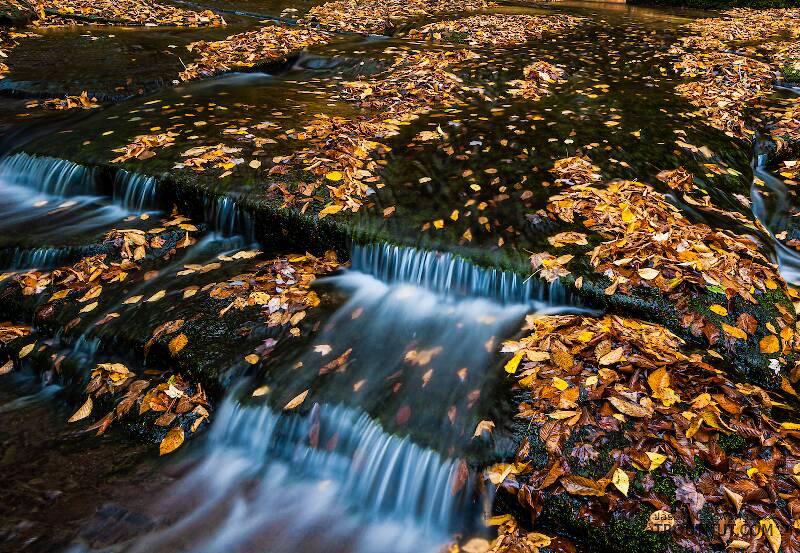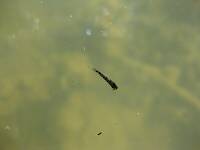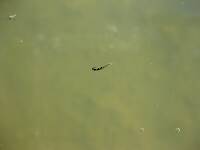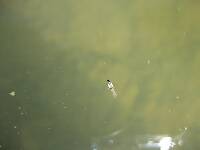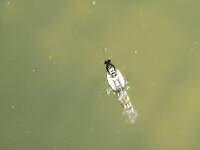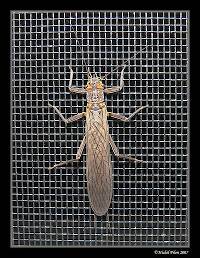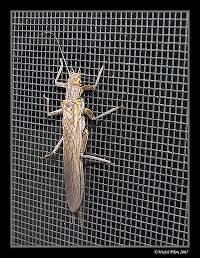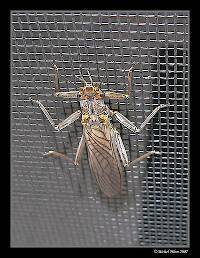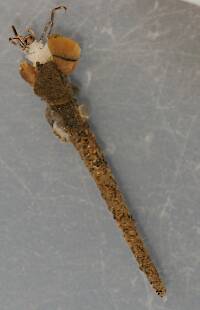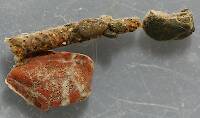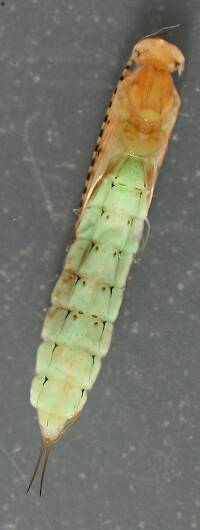
Hex Mayflies
Hexagenia limbata
The famous nocturnal Hex hatch of the Midwest (and a few other lucky locations) stirs to the surface mythically large brown trout that only touch streamers for the rest of the year.
Featured on the forum

Nymphs of this species were fairly common in late-winter kick net samples from the upper Yakima River. Although I could not find a key to species of Zapada nymphs, a revision of the Nemouridae family by Baumann (1975) includes the following helpful sentence: "2 cervical gills on each side of midline, 1 arising inside and 1 outside of lateral cervical sclerites, usually single and elongate, sometimes constricted but with 3 or 4 branches arising beyond gill base in Zapada cinctipes." This specimen clearly has the branches and is within the range of that species.

Troutnut is a project started in 2003 by salmonid ecologist Jason "Troutnut" Neuswanger to help anglers and
fly tyers unabashedly embrace the entomological side of the sport. Learn more about Troutnut or
support the project for an enhanced experience here.
Wbranch on Dec 4, 2011December 4th, 2011, 5:20 pm EST
For about fifteen years I've been spending two weeks on a tailwater in Montana in mid July. During the period I fish there are three predominant insects; PMD's, Tricos, and a cinnamon caddis. I have a good, productive, pattern for the adult caddis.
However as effective as the adult is to take fish that are sticking their heads out there are five times as many fish that are boiling to the drifting pupa. I was wondering if any one here knew the formal name for this pupa and also if you have any good photos of the pupal stage or can you direct me to a book where I might be able to view the fly so I could tie a few versions to see if I can improve my already great fishing by developing a consistent sub surface pattern for this fly. I'm also interested in what the larvae looks like too.
I tie the adult on a #18 TMC 100 but I also use a #20 TMC 100 for some particularly tough fish on flat water. The wing of the natural has a tannish cinnamon color. The body is only about half as long as the wings. I think it has antennae in the front and it seems to swarm most intensely (to the point I have to quit as they fly into my ears, nose, into my shirt, etc) between 8:00 pm. and 10:00 p.m. but I'm wondering if it isn't more a resultant of water temperature rather than time because earlier in the season, say early July they emerge as early as 6:00 p.m. but as the season progresses into late July the bugs often come off so late as to pretty much have no angling value.
Also is the swarming a result of that days earlier emergence or is the swarming the end product of a couple of days emergences? I ask that because it seems like there are always more caddisflies swarming than I have seen emerging?
I'm most interested in the colors of the pupa body, thorax and emergent wings.
However as effective as the adult is to take fish that are sticking their heads out there are five times as many fish that are boiling to the drifting pupa. I was wondering if any one here knew the formal name for this pupa and also if you have any good photos of the pupal stage or can you direct me to a book where I might be able to view the fly so I could tie a few versions to see if I can improve my already great fishing by developing a consistent sub surface pattern for this fly. I'm also interested in what the larvae looks like too.
I tie the adult on a #18 TMC 100 but I also use a #20 TMC 100 for some particularly tough fish on flat water. The wing of the natural has a tannish cinnamon color. The body is only about half as long as the wings. I think it has antennae in the front and it seems to swarm most intensely (to the point I have to quit as they fly into my ears, nose, into my shirt, etc) between 8:00 pm. and 10:00 p.m. but I'm wondering if it isn't more a resultant of water temperature rather than time because earlier in the season, say early July they emerge as early as 6:00 p.m. but as the season progresses into late July the bugs often come off so late as to pretty much have no angling value.
Also is the swarming a result of that days earlier emergence or is the swarming the end product of a couple of days emergences? I ask that because it seems like there are always more caddisflies swarming than I have seen emerging?
I'm most interested in the colors of the pupa body, thorax and emergent wings.
Catskill fly fisher for fifty-five years.
Taxon on Dec 4, 2011December 4th, 2011, 9:18 pm EST
Hi Matt-
Based on the descriptive information you provided, that being a profuse hatch of #18-#20 Cinnamon Caddis, starting at around 6 PM in early July, and later as season progresses, on upper Missouri River in Montana from Holter Dam to Craig, my guess is that they are of family Hydropsychidae and genus Cheumatopsyche. There is a wonderful Hydropsychidae Page on this website, which has great photos of larvae, pupae, and adults. After you've a chance to peruse at it and have any questions remaining, just pose them. Incidentally, I simply don't know the answer to the question you posed about swarming, but Kurt probably will.
Based on the descriptive information you provided, that being a profuse hatch of #18-#20 Cinnamon Caddis, starting at around 6 PM in early July, and later as season progresses, on upper Missouri River in Montana from Holter Dam to Craig, my guess is that they are of family Hydropsychidae and genus Cheumatopsyche. There is a wonderful Hydropsychidae Page on this website, which has great photos of larvae, pupae, and adults. After you've a chance to peruse at it and have any questions remaining, just pose them. Incidentally, I simply don't know the answer to the question you posed about swarming, but Kurt probably will.
Oldredbarn on Dec 5, 2011December 5th, 2011, 9:12 am EST
Matt,
I'm going to add a hedge here...The Little Tan Short-Horned Sedge. Glossosoma.
Just something else to think about...About a size 20 with tan-brown wing and greenish brown body...See LaFontaine's "Caddisflies" page 226 where he said that they, "create more selective feeding situations than any other organism at certain times of the year."
Read the part below it (same pages) where he writes about G alascense where he talks about doing a study on the Flathead and the numbers he found there. It's a saddle-case maker and leaves the case often and finds itself in the drift...It has a cousin G montana as well.
Don't forget, as you already probably know...Brachycentrus americanus may be about...The cousin of B occidentalis (the famous Mother's Day Caddis)... B americanus shows up later in the summer than MDC and like here, I think they call it the Little Black Caddis, or some such.
I think very tiny beadheads tied on small scud type hooks (TMC 2457) would work well. I also like short shank hooks for caddis...I'm at work and I can't remember hook numbers off the top of my head but you know what I mean. Just a thread body or wrapped pheasant tail or I like the UTC Gel-Spun stuff. Just a little hares-ear behind the bead...I fancy them up, just behind the bead with this gel spun thread for mayflies. Looks cool...If I can find it I'll PM you some pics.
I have been tying up something called the V-Caddis with vinyl rib...I haven't tied smaller sizes yet since I had to wait for a hook order from BRF. They look pretty cool...Scud hook again, thinly lay down a layer of dubbing (color you want to show thru), wrap the V-rib over it...Wrap a wrap or two of appropriate sized partridge hackle, and some peacock in front of that to the eye of the hook...No bead here...Only problem is finding Pat small enough for the tinier flies.
Side note...A tying friend of mine stayed with me last spring and we went out to Jo-Ann Fabrics...There is this stretchy clear tubing that the girls use for making braclets that works wonderfully for these sorts of things...The thread color or dubbing shows through the clear. Do you know Ann Conba, she's a tyer in Ireland? Mark Libertone turned me on to her stuff on that Danica web page set up by Hans Weilenmann...She does the same thing with the clear rib and just dubs the head with something that looks like ICE dubbing...She uses Glister Sparkle Dubbing (not sure if available here in US).
Anyway...Sorry for the disjointed ramble...I need to get back to work...;)
I feel that it is the accumulated product of the prior few days of emerging. Maybe Creno could chime in here but I feel these are mating swarms and can be frustrating and a delusion until the females finally get around to depositing the eggs.
I have seen very large swarms of caddis hovering just above the shrubs along the banks of the Madison towards evening. They eventually make it out over the water and then they start to touch down...Then the fish start to porpoise...I had an evening back in 95 there I'll never forget...I had to get up early to drive to Paradise Valley from Ennis the next morning and I'm very happy I decided to forgo a good nights sleep and stayed and fished in to dark.
I'll have to PM you Matt later sometime when I'm not sitting in the office...:)
Spence
I'm going to add a hedge here...The Little Tan Short-Horned Sedge. Glossosoma.
Just something else to think about...About a size 20 with tan-brown wing and greenish brown body...See LaFontaine's "Caddisflies" page 226 where he said that they, "create more selective feeding situations than any other organism at certain times of the year."
Read the part below it (same pages) where he writes about G alascense where he talks about doing a study on the Flathead and the numbers he found there. It's a saddle-case maker and leaves the case often and finds itself in the drift...It has a cousin G montana as well.
Don't forget, as you already probably know...Brachycentrus americanus may be about...The cousin of B occidentalis (the famous Mother's Day Caddis)... B americanus shows up later in the summer than MDC and like here, I think they call it the Little Black Caddis, or some such.
I think very tiny beadheads tied on small scud type hooks (TMC 2457) would work well. I also like short shank hooks for caddis...I'm at work and I can't remember hook numbers off the top of my head but you know what I mean. Just a thread body or wrapped pheasant tail or I like the UTC Gel-Spun stuff. Just a little hares-ear behind the bead...I fancy them up, just behind the bead with this gel spun thread for mayflies. Looks cool...If I can find it I'll PM you some pics.
I have been tying up something called the V-Caddis with vinyl rib...I haven't tied smaller sizes yet since I had to wait for a hook order from BRF. They look pretty cool...Scud hook again, thinly lay down a layer of dubbing (color you want to show thru), wrap the V-rib over it...Wrap a wrap or two of appropriate sized partridge hackle, and some peacock in front of that to the eye of the hook...No bead here...Only problem is finding Pat small enough for the tinier flies.
Side note...A tying friend of mine stayed with me last spring and we went out to Jo-Ann Fabrics...There is this stretchy clear tubing that the girls use for making braclets that works wonderfully for these sorts of things...The thread color or dubbing shows through the clear. Do you know Ann Conba, she's a tyer in Ireland? Mark Libertone turned me on to her stuff on that Danica web page set up by Hans Weilenmann...She does the same thing with the clear rib and just dubs the head with something that looks like ICE dubbing...She uses Glister Sparkle Dubbing (not sure if available here in US).
Anyway...Sorry for the disjointed ramble...I need to get back to work...;)
Also is the swarming a result of that days earlier emergence or is the swarming the end product of a couple of days emergences? I ask that because it seems like there are always more caddisflies swarming than I have seen emerging?
I feel that it is the accumulated product of the prior few days of emerging. Maybe Creno could chime in here but I feel these are mating swarms and can be frustrating and a delusion until the females finally get around to depositing the eggs.
I have seen very large swarms of caddis hovering just above the shrubs along the banks of the Madison towards evening. They eventually make it out over the water and then they start to touch down...Then the fish start to porpoise...I had an evening back in 95 there I'll never forget...I had to get up early to drive to Paradise Valley from Ennis the next morning and I'm very happy I decided to forgo a good nights sleep and stayed and fished in to dark.
I'll have to PM you Matt later sometime when I'm not sitting in the office...:)
Spence
"Even when my best efforts fail it's a satisfying challenge, and that, after all, is the essence of fly fishing." -Chauncy Lively
"Envy not the man who lives beside the river, but the man the river flows through." Joseph T Heywood
"Envy not the man who lives beside the river, but the man the river flows through." Joseph T Heywood
Entoman on Dec 5, 2011December 5th, 2011, 10:59 am EST
Matt -
Just as likely spent adults or diving egg-layers, especially since you mention that the drys work well for you. If the fish are really dialed in on pupae, it's my experience that the dry fly is usually fished in vain. If they are hydropsychids as Taxon suspects, they can and do emerge in the evenings so there could be a mix. If they are Glossosoma (Little Short-horned sedge) as Spence mentioned, they trickle off during the day so the evening activity would be sans pupa. Lepidostoma (Little Brown Sedge) can also enter the mix and complicate matters further. I have encountered all three there and at that time of year. High Summer is caddis cornucopia and I would be surprised if those evening flights you are encountering are made up of only one family. Depending on observations (and the fishes expressed preferences), I would swing a soft hackle or a sparkle egg layer wet. If they want it dead drift, I'll drop the same patterns off the end of a little parachute caddis a foot or so. On the Missouri, I've done real well with a little olive soft hackle size 16 (I've posted it somewhere here before). Most caddis pupa drift deep for some time before rising to the surface. During the hours before an emergence, it's hard to beat a B.H. Poopah or LaFontaine Sparkle Pupa drifted deep. I like the Pettis Glass-bead Pupa too.
Unfortunately, all the critters mentioned above can meet your description. It's a bit unclear what you mean by size. Are you using those hooks to match the body length, or total length with your wings hanging over the edge of the bend a little? Also, answers to the following questions will prove helpful if you can recall or noticed:
1. Were the wings solid or lightly mottled, perhaps with a tiny pale area 2/3 down from the head on the top edge?
2. Were the antennae as long or a little longer than total length (wing tip to lips) or noticeably shorter?
3. Did you notice if the antennae had fuzzy scapes (bases)?
Air temps. As Summer progresses, they are more comfortable in the darker hours.
From an angling perspective, you have hit on the key biological difference between mayflies and caddisflies. Most nights in the Summer, caddis will be everywhere - in the air... Sometimes the fish aren't even feeding on caddis. The flights in the evening can represent weeks of hatching and grossly inflates the number anglers think hatched that day - or are actually available to trout.
Hard to tell without samples. In addition to not being sure which critter we are talking about, the days (sometimes many days) old sample you may capture from the air will have a much darker body than the freshly emerged adult or pupa. Typically they are olive green or tannish in the families referenced above with darker wingpads and thorax/heads. They are larger in body than the adults but usually tend to run a little shorter in overall length. Adult female body lengths can vary dramatically pre and post ovipositing.
Regards,
Kurt
However as effective as the adult is to take fish that are sticking their heads out there are five times as many fish that are boiling to the drifting pupa
Just as likely spent adults or diving egg-layers, especially since you mention that the drys work well for you. If the fish are really dialed in on pupae, it's my experience that the dry fly is usually fished in vain. If they are hydropsychids as Taxon suspects, they can and do emerge in the evenings so there could be a mix. If they are Glossosoma (Little Short-horned sedge) as Spence mentioned, they trickle off during the day so the evening activity would be sans pupa. Lepidostoma (Little Brown Sedge) can also enter the mix and complicate matters further. I have encountered all three there and at that time of year. High Summer is caddis cornucopia and I would be surprised if those evening flights you are encountering are made up of only one family. Depending on observations (and the fishes expressed preferences), I would swing a soft hackle or a sparkle egg layer wet. If they want it dead drift, I'll drop the same patterns off the end of a little parachute caddis a foot or so. On the Missouri, I've done real well with a little olive soft hackle size 16 (I've posted it somewhere here before). Most caddis pupa drift deep for some time before rising to the surface. During the hours before an emergence, it's hard to beat a B.H. Poopah or LaFontaine Sparkle Pupa drifted deep. I like the Pettis Glass-bead Pupa too.
I tie the adult on a #18 TMC 100 but I also use a #20 TMC 100 for some particularly tough fish on flat water. The wing of the natural has a tannish cinnamon color. The body is only about half as long as the wings. I think it has antennae in the front...
Unfortunately, all the critters mentioned above can meet your description. It's a bit unclear what you mean by size. Are you using those hooks to match the body length, or total length with your wings hanging over the edge of the bend a little? Also, answers to the following questions will prove helpful if you can recall or noticed:
1. Were the wings solid or lightly mottled, perhaps with a tiny pale area 2/3 down from the head on the top edge?
2. Were the antennae as long or a little longer than total length (wing tip to lips) or noticeably shorter?
3. Did you notice if the antennae had fuzzy scapes (bases)?
...and it seems to swarm most intensely (to the point I have to quit as they fly into my ears, nose, into my shirt, etc) between 8:00 pm. and 10:00 p.m. but I'm wondering if it isn't more a resultant of water temperature rather than time because earlier in the season, say early July they emerge as early as 6:00 p.m. but as the season progresses into late July the bugs often come off so late as to pretty much have no angling value.
Air temps. As Summer progresses, they are more comfortable in the darker hours.
Also is the swarming a result of that days earlier emergence or is the swarming the end product of a couple of days emergences? I ask that because it seems like there are always more caddisflies swarming than I have seen emerging?
From an angling perspective, you have hit on the key biological difference between mayflies and caddisflies. Most nights in the Summer, caddis will be everywhere - in the air... Sometimes the fish aren't even feeding on caddis. The flights in the evening can represent weeks of hatching and grossly inflates the number anglers think hatched that day - or are actually available to trout.
I'm most interested in the colors of the pupa body, thorax and emergent wings.
Hard to tell without samples. In addition to not being sure which critter we are talking about, the days (sometimes many days) old sample you may capture from the air will have a much darker body than the freshly emerged adult or pupa. Typically they are olive green or tannish in the families referenced above with darker wingpads and thorax/heads. They are larger in body than the adults but usually tend to run a little shorter in overall length. Adult female body lengths can vary dramatically pre and post ovipositing.
Regards,
Kurt
"It's not that I find fishing so important, it's just that I find all other endeavors of Man equally unimportant... And not nearly as much fun!" Robert Traver, Anatomy of a Fisherman
Entoman on Dec 5, 2011December 5th, 2011, 11:33 am EST
Spence -
I think he is referring to the genus' propensity for behavioral drift as naked larvae. They often do so in tremendous numbers, usually at first light in the Summer. The problem is it's not a visual thing, so its very hard to know when it's happening. I can't recall an instance of glossosoma emerging in numbers to interest trout much, let alone cause selective feeding. A little larva imitation fished deep in the morning would be a great fly to use, though I admit that little bead-heads and other attractor nymphs usually go in the water when I'm fishing their habitat on Summer mornings (if I'm not fishing dry flies). Evening flights are another matter.:) They can be very thick (to the point of annoying).
...See LaFontaine's "Caddisflies" page 226 where he said that they, "create more selective feeding situations than any other organism at certain times of the year."
I think he is referring to the genus' propensity for behavioral drift as naked larvae. They often do so in tremendous numbers, usually at first light in the Summer. The problem is it's not a visual thing, so its very hard to know when it's happening. I can't recall an instance of glossosoma emerging in numbers to interest trout much, let alone cause selective feeding. A little larva imitation fished deep in the morning would be a great fly to use, though I admit that little bead-heads and other attractor nymphs usually go in the water when I'm fishing their habitat on Summer mornings (if I'm not fishing dry flies). Evening flights are another matter.:) They can be very thick (to the point of annoying).
"It's not that I find fishing so important, it's just that I find all other endeavors of Man equally unimportant... And not nearly as much fun!" Robert Traver, Anatomy of a Fisherman
Oldredbarn on Dec 5, 2011December 5th, 2011, 11:57 am EST
I think he is referring to the genus' propensity for behavioral drift as naked larvae.
Kurt, Yes I think so as well.
"Even when my best efforts fail it's a satisfying challenge, and that, after all, is the essence of fly fishing." -Chauncy Lively
"Envy not the man who lives beside the river, but the man the river flows through." Joseph T Heywood
"Envy not the man who lives beside the river, but the man the river flows through." Joseph T Heywood
Wbranch on Dec 5, 2011December 5th, 2011, 3:59 pm EST
Hello Roger,
Thank you for your scientific answer to my laymans inquiry. As it turns out, before I composed my Troutnut thread, I Googled "Montana Caddisflies" and "Caddisflies of the Missouri River watershed" and got quite a few hits.
One of them suggested Hydropsyche genus Cheumatopsyche and also Glossosoma.
I'll look at the data on the pupa and tie a buch of different flies and see which one works the best.
I happened to look at air fares today to Helena, MT and they were so low, for the period I wanted, that I didn't hestitate and booked my trip. The round trip fare leaving from Baltimore (BWI) is $82.00 less than last year.
Thank you for your scientific answer to my laymans inquiry. As it turns out, before I composed my Troutnut thread, I Googled "Montana Caddisflies" and "Caddisflies of the Missouri River watershed" and got quite a few hits.
One of them suggested Hydropsyche genus Cheumatopsyche and also Glossosoma.
I'll look at the data on the pupa and tie a buch of different flies and see which one works the best.
I happened to look at air fares today to Helena, MT and they were so low, for the period I wanted, that I didn't hestitate and booked my trip. The round trip fare leaving from Baltimore (BWI) is $82.00 less than last year.
Catskill fly fisher for fifty-five years.
Wbranch on Dec 5, 2011December 5th, 2011, 4:17 pm EST
Hi Kurt,
You wrote; "Unfortunately, all the critters mentioned above can meet your description. It's a bit unclear what you mean by size. Are you using those hooks to match the body length, or total length with your wings hanging over the edge of the bend a little? Also, answers to the following questions will prove helpful if you can recall or noticed:
1. Were the wings solid or lightly mottled (this can be very subtle), perhaps with a tiny pale area 2/3 down from the head on the top edge?
2. Were the antennae as long or a little longer than total length (wing tip to lips) or noticeably shorter?
3. Did you notice if the antennae had fuzzy scapes (bases)?
I use the hooks mentioned to replicate the total wing length irregardless of the abdomen length. The length of the wings is equal to the length of the hook shank, maybe up to 1/16" longer. In my experience with the adult even though the abdomen of the natural is only about 1/2 the length of the wing the trout don't seem to give a hoot. So I dub the body from the point where the shank is straight to about 1/16" from the eye, then tie in the wings which are tied to lay absolutely flat on the body, then dub more of the same body fur in front of the wing, a little more rotund than the abdomen and then just whip it off.
My recollection of the wing is that it is solid colored more of a dark cinammon than light. It is not mottled. The antennae are no longer than the total length of the insect. I have no clue to the answer of your #3.
When the fish really key in on the sub surface insect, which is most noticeable when the insects start to swarm, the effectivity of the dry adult drops to a point where if I were catching ten fish an hour during the daylight period my catch rate would go down to maybe 1 - 2 when the fish engage in heavy surface film, or just below the surface, feeding. If I could ever get a pupal pattern that was just 50% as effective as the adult I'd be having thirty fish days of 17" - 21" fish!
You wrote; "Unfortunately, all the critters mentioned above can meet your description. It's a bit unclear what you mean by size. Are you using those hooks to match the body length, or total length with your wings hanging over the edge of the bend a little? Also, answers to the following questions will prove helpful if you can recall or noticed:
1. Were the wings solid or lightly mottled (this can be very subtle), perhaps with a tiny pale area 2/3 down from the head on the top edge?
2. Were the antennae as long or a little longer than total length (wing tip to lips) or noticeably shorter?
3. Did you notice if the antennae had fuzzy scapes (bases)?
I use the hooks mentioned to replicate the total wing length irregardless of the abdomen length. The length of the wings is equal to the length of the hook shank, maybe up to 1/16" longer. In my experience with the adult even though the abdomen of the natural is only about 1/2 the length of the wing the trout don't seem to give a hoot. So I dub the body from the point where the shank is straight to about 1/16" from the eye, then tie in the wings which are tied to lay absolutely flat on the body, then dub more of the same body fur in front of the wing, a little more rotund than the abdomen and then just whip it off.
My recollection of the wing is that it is solid colored more of a dark cinammon than light. It is not mottled. The antennae are no longer than the total length of the insect. I have no clue to the answer of your #3.
When the fish really key in on the sub surface insect, which is most noticeable when the insects start to swarm, the effectivity of the dry adult drops to a point where if I were catching ten fish an hour during the daylight period my catch rate would go down to maybe 1 - 2 when the fish engage in heavy surface film, or just below the surface, feeding. If I could ever get a pupal pattern that was just 50% as effective as the adult I'd be having thirty fish days of 17" - 21" fish!
Catskill fly fisher for fifty-five years.
PaulRoberts on Dec 5, 2011December 5th, 2011, 5:19 pm EST
If they turn out to be Hydropsychids, try a diving adult pattern. Your 30+ fish days could come true. With the Hydros I fished a lot, the pupae came earlier in the day, with the divers coming on in the evening. The diver pattern was the real killer.
I discovered them by accident, turning rocks. Adults were all over but I couldn't turn a decent fish on dries. Pupae did better but fell off in effectiveness as the day wore on. The behavior to watch for are some adults flopping on the surface -apparently they have to break through.
Switching to a diver -with a reflective overwing -just blew the doors open for me.
I discovered them by accident, turning rocks. Adults were all over but I couldn't turn a decent fish on dries. Pupae did better but fell off in effectiveness as the day wore on. The behavior to watch for are some adults flopping on the surface -apparently they have to break through.
Switching to a diver -with a reflective overwing -just blew the doors open for me.
Entoman on Dec 5, 2011December 5th, 2011, 5:36 pm EST
The length of the wings is equal to the length of the hook shank, maybe up to 1/16" longer.
That's what I figured, I just wanted to make sure. That doesn't eliminate any of the three, but the odds are it's not something else. The brachycentrids can be that small, but on that river the wings are much darker. If you have the chance this Summer, take a close look at the antennae:
Noticeably shorter - Glossosoma (Little Short-horned Sedge)
Same approx. length - Cheumatopshche (Little Sister Sedge)
Same approx. length with fuzzy bases - Lepidostoma (Little Brown Sedge)
When the fish really key in on the sub surface insect, which is most noticeable when the insects start to swarm...
That sounds like feeding on Glossosoma or Cheumatopsyche diving egg-layers. (Edit - Sorry, didn't see your post until after, Paul. Good to know we agree though.) They swim under water in hydropsychid fashion to lay their eggs. However - there could also be an emergence going on at the same time, with different fish focusing on different stages. If I'm not sure, I'll often swing the wet fly with a pupa on the dropper (or vice-versa) and let the fish tell me. Sometimes that get real picky about wanting them dead drift as the pupa don't always shoot through the surface as popularly portrayed but actually drift a bit under the film. If they aren't reacting well to the swinging fly, try dropping one off the back of a caddis dry first for some dead drifts before giving up on them. I like the parachute for this, 'cause I can see that fluorescent pink post well. The Missouri is a tough enough river to see little flies on without all those little crappers crawling around on your face. Ever have one go up your nose?:) The fact that the parachute caddis does a decent job of mimicking the spent caddis isn't a bad thing, either.
If I could ever get a pupal pattern that was just 50% as effective...
Try a good egglayer imitation and you might find it 200% as effective. It is possible that you could be experiencing the emergence of a different species than the one that is swarming, which can be very confusing to say the least. I fthis is the case, I've had excellent luck with this pattern in amber tan (shown) and in greenish olive. The caddis pupa has a bulbous head tapering to a thin neck. I know it seems like a small thing, but this fly incorporates that natural shape and I think it's important. The halo of antron is a big trigger as well. The long V antennae are really only there to assist the fly to stay upright, but it doesn't hurt that they look natural.
Halo Pupa (tan) Size 18
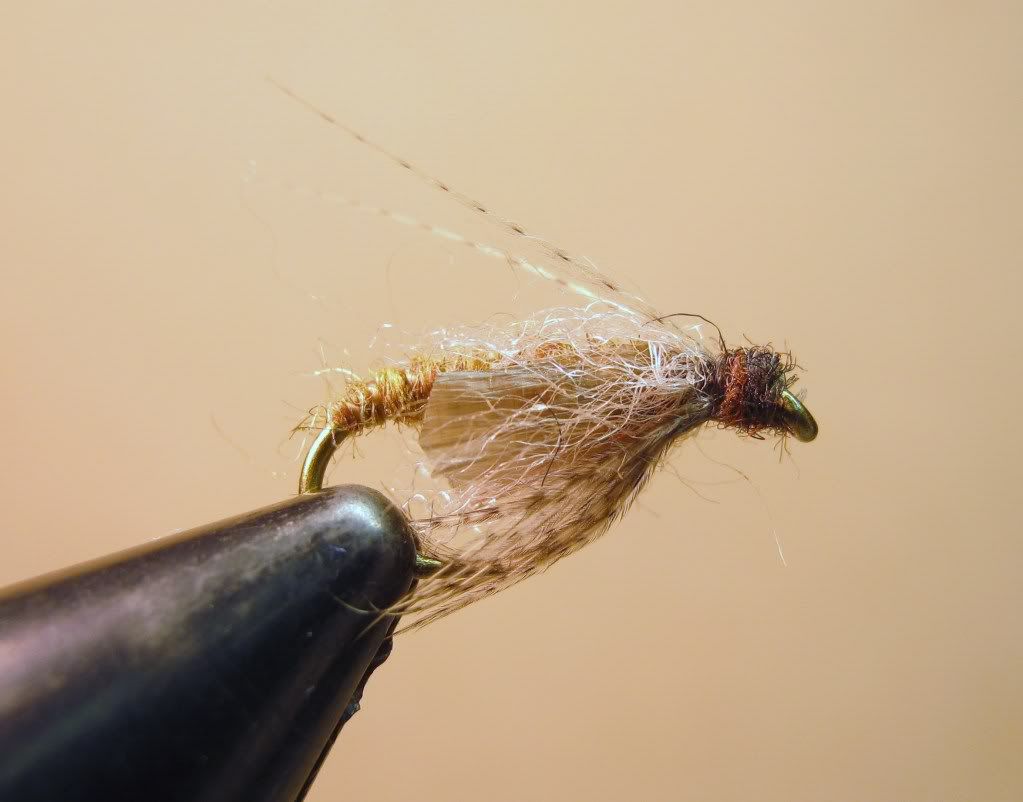
Material list (in order of application):
Hook - TMC 100 or 3769
Thread - matching 8/0 UNI
Rib - 3/0 monocord to compliment (tan in this one)
Body - Scintilla or buggy Nymph to match (med. amber in this one)
Wings - swiss straw to match (brown in this one)
Collar - Antron to compliment (tan in this one)
Legs - feather barbules to match (partridge in this one)
Antennae - feather barbules or hair fibers to compliment (woodduck on this one)
Head - Scintilla or Buggy Nymph dubbing to compliment ( two browns and black)
Notes: Finish the fly well back from the eye to leave room for the head tapering back to a thin neck. the whip knot is applied in the neck area. Use swiss straw for the wings - not medalian sheeting or other similar material as the swiss straw softens when wet for a very natural look. For strength, loop the piece of straw around the thread and tie in underneath the the shank. trim to length once it's in place. The "halo" is created by trimming a piece of antron yarn twice the length of the hook, spreading it in a dubbing loop and lightly twisted before wrapping. Be sparse with this - a little goes a long way.
"It's not that I find fishing so important, it's just that I find all other endeavors of Man equally unimportant... And not nearly as much fun!" Robert Traver, Anatomy of a Fisherman
Entoman on Dec 5, 2011December 5th, 2011, 6:11 pm EST
Paul,
That's usually my experience as well. My only caveat is Matt has been around the block a time or two when it comes to experience and knows this river pretty well in that mid-Summer time slot. If he is pretty sure that they are eating pupa, they probably are (until he proves one way or the other this coming Summer). The hydropsychids can & do emerge in the evening in certain circumstances. I've had excellent Hydropsyche pupa fishing on some CA low elevation tailwaters in the evening. The section of the Missouri we are discussing is a tailwater.
Regards,
Kurt
With the Hydros I fished a lot, the pupae came earlier in the day, with the divers coming on in the evening.
That's usually my experience as well. My only caveat is Matt has been around the block a time or two when it comes to experience and knows this river pretty well in that mid-Summer time slot. If he is pretty sure that they are eating pupa, they probably are (until he proves one way or the other this coming Summer). The hydropsychids can & do emerge in the evening in certain circumstances. I've had excellent Hydropsyche pupa fishing on some CA low elevation tailwaters in the evening. The section of the Missouri we are discussing is a tailwater.
Regards,
Kurt
"It's not that I find fishing so important, it's just that I find all other endeavors of Man equally unimportant... And not nearly as much fun!" Robert Traver, Anatomy of a Fisherman
Wbranch on Dec 5, 2011December 5th, 2011, 6:30 pm EST
Hi Kurt,
You wrote; " Ever have one go up your nose?:)"
Actually worse! I had one not only go into the outer left ear but the SOB crawled into my inner ear and I could feel/hear it's wings beating in my ear. It was really flipping me out. I clammered to the edge of the river, laid my rod down, and cupped my hand into the river and turned my head down and tried to pour water into my ear to drown the bastard. I was able to kill it and thought I flushed it out of my ear..
After I got home I felt fine but sometime in November, three months after the incident, I could feel there was something still in my ear. I went to the doctor and told him what had happened back in late July. He took his light and some long tweezers and dug around and after a couple tries he started to bring out pieces of that damn caddis adult. Really grossed me out. It came out in three pieces. Now I bring foam ear plugs out with me and just prior to the swarming period I put them in my ears so I don't ever have to go through that again.
You wrote; " Ever have one go up your nose?:)"
Actually worse! I had one not only go into the outer left ear but the SOB crawled into my inner ear and I could feel/hear it's wings beating in my ear. It was really flipping me out. I clammered to the edge of the river, laid my rod down, and cupped my hand into the river and turned my head down and tried to pour water into my ear to drown the bastard. I was able to kill it and thought I flushed it out of my ear..
After I got home I felt fine but sometime in November, three months after the incident, I could feel there was something still in my ear. I went to the doctor and told him what had happened back in late July. He took his light and some long tweezers and dug around and after a couple tries he started to bring out pieces of that damn caddis adult. Really grossed me out. It came out in three pieces. Now I bring foam ear plugs out with me and just prior to the swarming period I put them in my ears so I don't ever have to go through that again.
Catskill fly fisher for fifty-five years.
Wbranch on Dec 5, 2011December 5th, 2011, 6:34 pm EST
Kurt,
Thanks for all the details and the fly pattern pattern and other suggestions. I've got six and a half months to tie a couple dozen of each pattern. I'll also tie some LaFontaine emergent pupa in those colors. I've always done well with those flies in other areas so should try them on the 'Moe.
I'll print all the responses for reference.
Thanks for all the details and the fly pattern pattern and other suggestions. I've got six and a half months to tie a couple dozen of each pattern. I'll also tie some LaFontaine emergent pupa in those colors. I've always done well with those flies in other areas so should try them on the 'Moe.
I'll print all the responses for reference.
Catskill fly fisher for fifty-five years.
Entoman on Dec 5, 2011December 5th, 2011, 6:51 pm EST
You're welcome, Matt. Looking forward to the reporting (though I'd prefer to be in the boat with you).:)
BTW - That is quite a story about the "ear" caddis. Now I'm going to wear ear plugs as well as the cowboy scarf pulled up over my mouth and nose. Thank God it didn't cause a severe ear infection. That little bastard could have cost you your hearing out of that ear!
BTW - That is quite a story about the "ear" caddis. Now I'm going to wear ear plugs as well as the cowboy scarf pulled up over my mouth and nose. Thank God it didn't cause a severe ear infection. That little bastard could have cost you your hearing out of that ear!
"It's not that I find fishing so important, it's just that I find all other endeavors of Man equally unimportant... And not nearly as much fun!" Robert Traver, Anatomy of a Fisherman
Wbranch on Dec 5, 2011December 5th, 2011, 7:39 pm EST
Kurt,
"That little bastard could have cost you your hearing out of that ear!"
What was that? Can you please write louder LOL!
Yea, it would be nice to get a pupal pattern that worked decent during that evening period. It can be frustrating to kick butt all through the daylight hours but come around 7:00 pm there are just less and less heads and snouts and more boils and dorsals breaking the surface.
"That little bastard could have cost you your hearing out of that ear!"
What was that? Can you please write louder LOL!
Yea, it would be nice to get a pupal pattern that worked decent during that evening period. It can be frustrating to kick butt all through the daylight hours but come around 7:00 pm there are just less and less heads and snouts and more boils and dorsals breaking the surface.
Catskill fly fisher for fifty-five years.
Entoman on Dec 5, 2011December 5th, 2011, 8:11 pm EST
Matt,
LOL! _ Sorry, I can't write any louder 'cause Jason's put a freeze on font size and he frowns on all caps. Something about shouting too close to the face with garlic and Sardine oil or something....:)
You nailed it! A problem we spend a lot of skill, time & brain power trying to solve with all our fly designs & presentation schemes. Once in a blue moon we do well and think by Jove, we finally have it! Until the next night... :)
Regards,
Kurt
LOL! _ Sorry, I can't write any louder 'cause Jason's put a freeze on font size and he frowns on all caps. Something about shouting too close to the face with garlic and Sardine oil or something....:)
... around 7:00 pm there are just less and less heads and snouts and more boils and dorsals breaking the surface.
You nailed it! A problem we spend a lot of skill, time & brain power trying to solve with all our fly designs & presentation schemes. Once in a blue moon we do well and think by Jove, we finally have it! Until the next night... :)
Regards,
Kurt
"It's not that I find fishing so important, it's just that I find all other endeavors of Man equally unimportant... And not nearly as much fun!" Robert Traver, Anatomy of a Fisherman
Sayfu
Posts: 560
Posts: 560
Sayfu on Dec 6, 2011December 6th, 2011, 4:20 am EST
Wbranch. That is why I like the wind blowing from left to right. Not only is my right handed casting much better, but the swarming caddis blow right through my ears.
Wbranch on Dec 6, 2011December 6th, 2011, 4:40 am EST
Kurt,
Would you mind giving me the material list for the pictured pupa? Thanks.
Would you mind giving me the material list for the pictured pupa? Thanks.
Catskill fly fisher for fifty-five years.
Oldredbarn on Dec 6, 2011December 6th, 2011, 5:30 am EST
Matt,
I know this is terrible but I'm laughing my ass off this morning after reading about your "earwig" episode! :) And I thought it was bad enough to have eaten a few dozen by accident over the years! I'm not sure but, being a vegetarian and all, does chowing down on caddis mess with my karma? ;)
Spence
PS Me too? :)
I just noticed something that made my palms sweat...The number of my posts are greater than Kurt's and he's a member of the site police...I better just get back to work...;) See ya! Gotta go...
I know this is terrible but I'm laughing my ass off this morning after reading about your "earwig" episode! :) And I thought it was bad enough to have eaten a few dozen by accident over the years! I'm not sure but, being a vegetarian and all, does chowing down on caddis mess with my karma? ;)
Spence
PS
Would you mind giving me the material list for the pictured pupa? Thanks
I just noticed something that made my palms sweat...The number of my posts are greater than Kurt's and he's a member of the site police...I better just get back to work...;) See ya! Gotta go...
"Even when my best efforts fail it's a satisfying challenge, and that, after all, is the essence of fly fishing." -Chauncy Lively
"Envy not the man who lives beside the river, but the man the river flows through." Joseph T Heywood
"Envy not the man who lives beside the river, but the man the river flows through." Joseph T Heywood
Entoman on Dec 6, 2011December 6th, 2011, 10:09 am EST
Guys -
See post edit below the photo.
Regards,
Kurt
See post edit below the photo.
Regards,
Kurt
"It's not that I find fishing so important, it's just that I find all other endeavors of Man equally unimportant... And not nearly as much fun!" Robert Traver, Anatomy of a Fisherman
Quick Reply
Related Discussions
Topic
Replies
Last Reply
4
Apr 16, 2007
by GONZO
by GONZO

